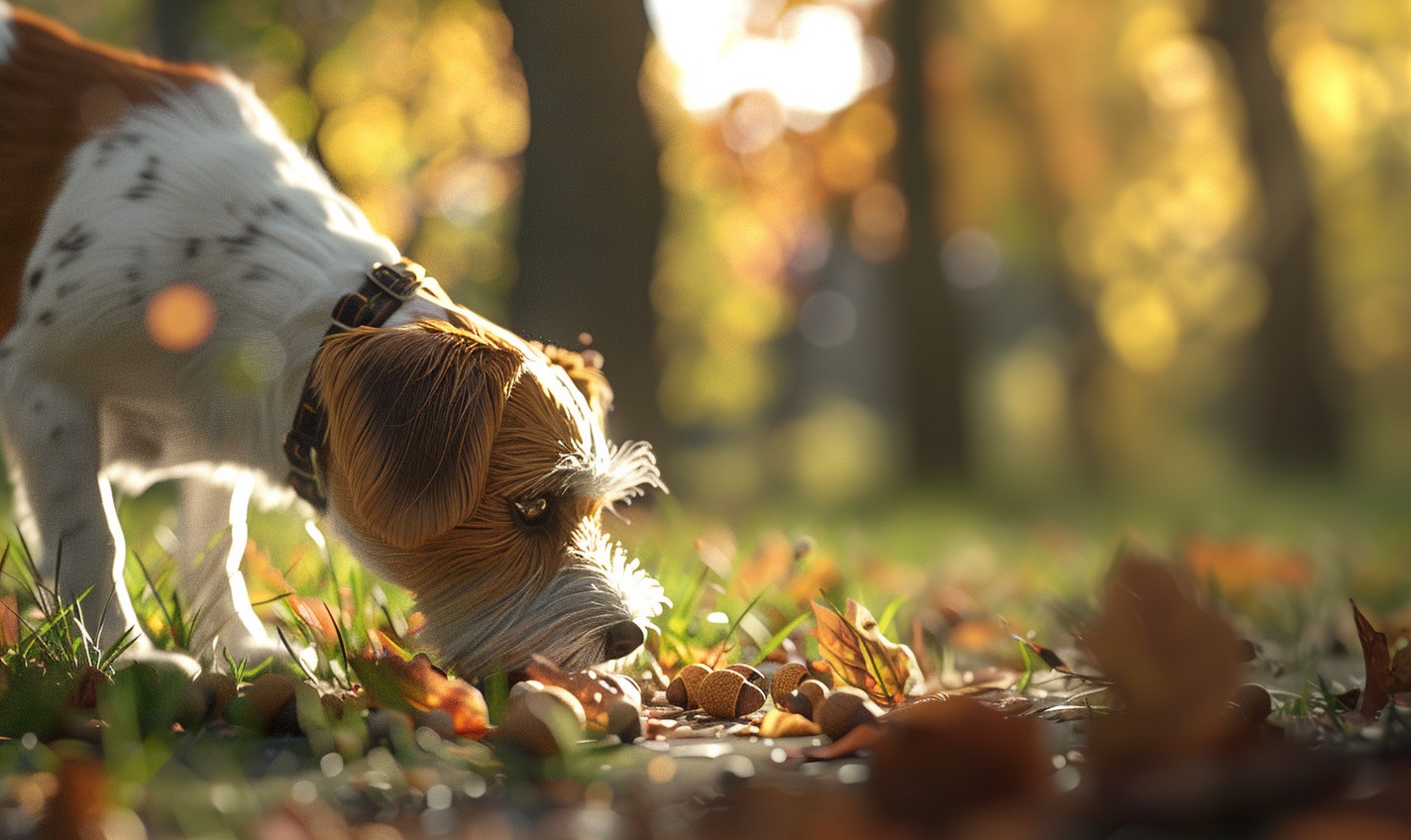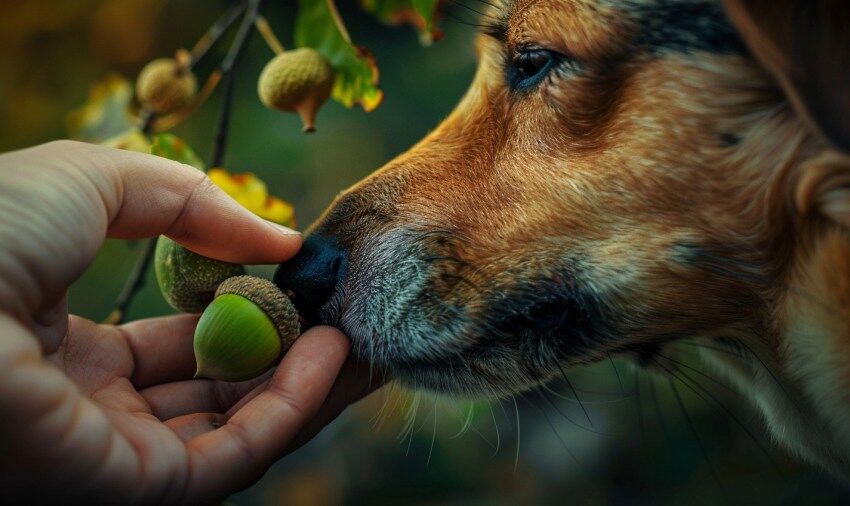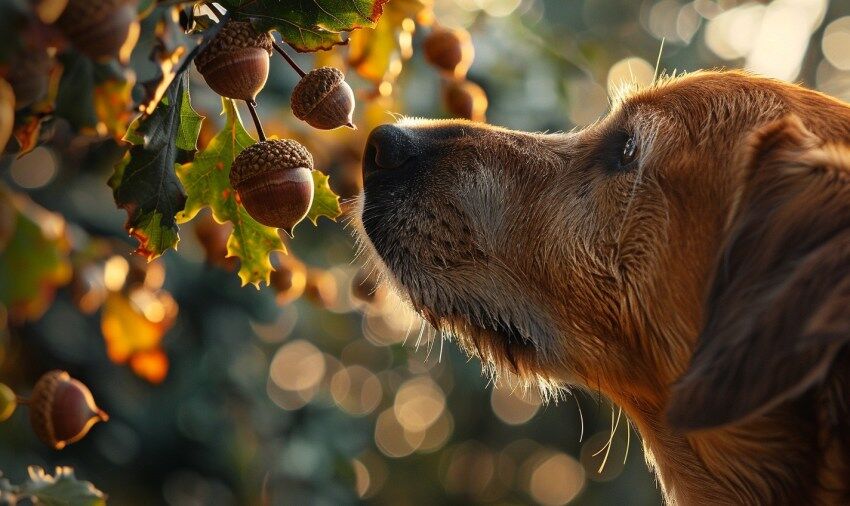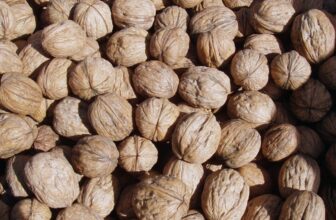
[ad_1]
Can dogs eat acorns? When you’re a dog owner, it’s only natural to wonder about the safety of every food item your furry friend might come across. Whether you’re committed to giving your dog a daily walk or you might be an actual dog walker, I’m sure you’ve wondered whether or not dogs can eat acorns because they’re everywhere!
In this article, we’ll crack open the mystery of acorn safety and explore the potential dangers to our canine companions.

The Acorn Dilemma: Friend or Foe for Dogs?
Acorns are those small, nut-like seeds that fall from oak trees; they can be found in various shapes and sizes. While they’re a staple food source for wildlife like squirrels and deer, the question remains: Are acorns harmful for dogs?
But first, let’s address the other question that’s probably floating in the back of your mind…can YOU eat acorns? Who wouldn’t want to know about an emergency food source, right? Plus, the answer actually plays a role in whether or not they’re safe for Fido.
Well, it depends on how acorns are prepared. Raw acorns have tannins, a bitter-tasting compound found in wood, bark, and various plant leaves. Plants create tannins as a defense mechanism to prevent animals from eating them before they’re ripe.
If a plant tastes bitter, then it’s unlikely that an animal will chomp on it for lunch. Survival of the most bitter, remember?
Well, that’s what you’d think until you enter the world of dark chocolate, tea, coffee, and wine that some of us humans love to eat…but that’s a different topic for later time (but in case you’re curious, NONE of those things are safe for your dog).
Tannins from raw acorns are definitely toxic for humans. Those same tannins are also toxic for dogs.
So let’s dive into what could happen if your dog chomps on an acorn without your permission.

The Three Major Dangers of Dogs Eating Acorns
Acorn tannins, specifically Gallotannin, can cause digestive issues like upset stomach, diarrhea, and vomiting when ingested in large quantities.
Eating large acorn quantities may not happen on your watch, but if you let your dog out in an enclosed backyard unsupervised, it’s always a possibility.
But that’s not the only bad part. If your dog eats just one acorn, here’s how ugly it can get:
Choking Hazard:
Acorns come in various sizes, and smaller dogs, in particular, may attempt to swallow them whole.
This can pose a choking hazard or lead to an obstruction in the digestive tract.
As a pet parent, it’s in your best interest to know how to perform CPR on your dog. Check out the video below to learn how.
Damage to Teeth:
Gnawing on hard acorns can damage a dog’s teeth, potentially leading to fractures or other dental issues.
When my dog lost teeth due to old age, she literally kept biting off more than she could chew.
I had to switch to quality soft food for senior dogs and manage every eating session.
Sadly, Rosie later died from choking on food while I slept.
Intestinal Blockages:
Ingesting acorns with their tough shells intact can lead to intestinal blockages, which may require surgery.
In today’s economy, an unexpected vet bill could devastate your finances.
When my first Chihuahua Tinkerbell fell ill from hypoglycemia, I had to charge a credit card with an extremely high-interest rate.
Long-term Effects
Frequent consumption of acorns can also lead to long-term health issues, such as kidney damage. The tannins in acorns can cause damage to the kidneys over time, leading to chronic kidney disease (CKD).
This is particularly concerning because CKD is irreversible and can significantly impact a dog’s quality of life.

Are there any dog-safe tree nuts?
The answer to that isn’t a simple “yes” or “no.” In my opinion, though, no, there aren’t any truly 100% dog-safe tree nuts.
Even though there are non-toxic nuts for dogs like almonds and chestnuts, you still have to contend with possible upset stomachs or intestinal blockage.
You may be wondering about coconuts. After all, we know that they’re typically safe for dogs. However, despite the name (and the fact that the FDA lists it on their list of tree nut allergens), coconuts are actually a fruit…NOT a nut. However, even with coconut you still have to be careful and only feed it to your dog in moderation.
It’s important to consider if there are any potential benefits to allowing your dog to eat any nut in moderation that outweigh the hazards. Usually, there are none. As always, consult your veterinarian for direct advice.
Training Your Dog to Avoid Dangerous Foods
Now that we’ve explored the life-threatening dangers of acorns, it’s crucial to understand how you can train your dog to avoid eating harmful substances, not just acorns…but ANY potentially dangerous foods they might encounter.
Here’s how to protect your dog from harm:
Basic Obedience Training
Start with basic obedience commands like “drop it” and “leave it.”
These commands can be invaluable in situations where your dog is tempted by something they shouldn’t eat, like acorns.
While both commands may seem similar, they have different intentions.
The “Drop It” command is intended to remove an object from a dog’s mouth while “Leave It” prevents the dog from picking it up in the first place.
The “Drop It” command is best for puppies who are exploring their new world through their mouths.
The “Leave It’ command is best for objects that your dog hasn’t reached yet.
Here’s how Jake and Louise, dog trainers from Red Pointy Dog, teach the “Leave It” life-saving command:
”Leave It” Command
Start by showing your dog an ‘okay’ treat in your closed hand.
When they show interest, say ‘leave it’ and wait for them to stop trying to get the treat.
Jake and Lousie also remind us that, “‘Leave It’ means your dog can never have that treat. If you reward them with what you are asking them to leave, that turns it into more of a Wait.”
As soon as your dog does leave it alone, reward them with a DIFFERENT treat or praise with your opposite hand.
Positive reinforcement encourages dogs to make the right choices, like avoiding dangerous items.
Introduce a challenge by opening your hand that’s holding the banned treat, little by little, until it can be left unattended on the ground.
Practice this command regularly until your dog shows mastery.
Supervision
Whenever your dog is outdoors, especially in areas where acorns are prevalent, an easy way to keep them safe is with a close eye.
If you notice them showing interest in acorns, intervene immediately and redirect their attention to a safer activity or toy.
Proceed with Caution
In a nutshell, there’s no debate about whether or not acorns are bad for dogs: acorns are poisonous for dogs.
As responsible dog owners, our priority should always be the safety and well-being of our furry companions.
The dangers of giving your dog any kind of nut include digestive upset, choking hazards, dental damage, and the potential for intestinal blockages.
Remember, the key to keeping your dog safe is a combination of proper training, supervision, and a good understanding of potential hazards.
With these tools in your toolkit, you can help your dog make the right choices and keep them out of harm’s way, whether it’s avoiding acorns or any other potentially dangerous food items.
Your four-legged friend will thank you for it with a lifetime of tail wags!
Common FAQs about acorns and dogs:
We covered all of these above, but for those of you who prefer a short and sweet answer, here’s a recap:
Can dogs eat acorns?
No. Acorns contain toxic chemicals called “tannins,” which are highly poisonous to dogs. Acorns are so toxic to dogs that ingestion can cause liver or kidney failure in rare cases. Not even ONE acorn is safe for a dog to eat!
What can I do if my dog eats an acorn?
Contact your vet immediately if you think your dog has eaten acorns!
What does acorn poisoning look like in a dog?
Look for vomiting, diarrhea, and lethargy. Regular veterinary checkups can help detect any health issues related to your dog’s diet, including any problems from accidental ingestion of harmful substances that could take days to reveal themselves.
The hazards of nuts far outweigh the benefits. There are safer ways to provide essential nutrients to your dog. Remember, always prioritize your dog’s health and consult with a veterinarian if you have any concerns about their diet or if they ingest potentially harmful substances.
[ad_2]





